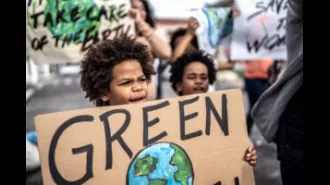Tim Cook explains why Apple manufactures iPhones in China
Trump wants Apple to make devices in the US, but the company is expanding production in India and still relies heavily on China for a crucial component.
April 13th 2025.

Earlier this week, there was a lot of talk about Apple and where they should be manufacturing their products. Former U.S. President Donald Trump stirred up the conversation by urging Apple to move its production to the United States. This suggestion plays into the growing trend of economic nationalism, but the reality is not so straightforward. While Trump advocates for American manufacturing, Apple has been quietly expanding its production base in India, while still heavily relying on China, not just for cheap labor, but for something far more crucial.
A resurfaced 2024 video of Apple CEO Tim Cook has brought renewed attention to the question: Why does Apple continue to manufacture in China? In the short 55-second clip, Cook debunks the common belief that Apple is in China to save money on wages. He explains that the idea of China being a low-cost manufacturing destination is outdated, and that China stopped being a low-cost hub for manufacturing years ago. So, why is Apple still so invested in China?
According to Cook, the main reason is because of the abundance of skilled labor in China, specifically in high-precision tooling and materials engineering. These are essential skills for producing the complex and high-performance devices that Apple is known for, and China has a deep concentration of these skilled workers. In contrast, Cook suggests that it would be challenging to even fill a single room with such professionals in the United States, while in China, one could fill multiple football fields.
Cook's explanation sheds light on why China remains central to Apple's supply chain. However, this is not stopping the company from exploring other options. In the past 12 months, Apple has assembled $22 billion worth of iPhones in India, marking a 60 percent increase from the previous year. This shows the company's efforts to diversify its production beyond China.
India is quickly becoming a viable alternative for strategic manufacturing. Apple's contract manufacturers are currently building what is expected to be the world's second-largest iPhone factory in the country. This move is part of a larger plan to reduce reliance on China due to geopolitical tensions, trade uncertainties, and pressure to decentralize production networks.
While some, including Trump and U.S. officials, hope that Apple will eventually bring its manufacturing back to American soil, industry experts remain skeptical. White House Press Secretary Karoline Leavitt points to Apple's recent announcement of a $500 billion domestic investment over the next four years as a sign of confidence in American capabilities. However, a Bloomberg report suggests that large-scale iPhone production in the U.S. is unlikely to happen anytime soon due to the lack of necessary infrastructure, skilled labor, and supplier networks. Unlike Asia, the U.S. does not yet have the vertically integrated environment that Apple requires for its advanced manufacturing processes.
This situation highlights the complex and often misunderstood nature of global manufacturing. While there may be political pressure to bring jobs back to the U.S., the precision, speed, and scale required for high-end electronics manufacturing make such transitions difficult. Apple's shift towards India is not just about cutting costs or managing political risks. It is a long-term strategy to build resilience by leveraging multiple geographies. With its growing pool of skilled workers, favorable government policies, and increasing investment in infrastructure, India presents a viable path forward for Apple.
As Apple navigates political expectations in the U.S., maintains its strong ties in China, and expands its production capacity in India, the company's supply chain is evolving into a complex global network. Despite the pressure to bring jobs back to the U.S., Tim Cook's comments make it clear that advanced manufacturing is ultimately a matter of capability, not just cost. In today's fiercely competitive tech landscape, where precision and speed are crucial, it's not about where it's cheapest to make an iPhone. It's about where it's possible.
A resurfaced 2024 video of Apple CEO Tim Cook has brought renewed attention to the question: Why does Apple continue to manufacture in China? In the short 55-second clip, Cook debunks the common belief that Apple is in China to save money on wages. He explains that the idea of China being a low-cost manufacturing destination is outdated, and that China stopped being a low-cost hub for manufacturing years ago. So, why is Apple still so invested in China?
According to Cook, the main reason is because of the abundance of skilled labor in China, specifically in high-precision tooling and materials engineering. These are essential skills for producing the complex and high-performance devices that Apple is known for, and China has a deep concentration of these skilled workers. In contrast, Cook suggests that it would be challenging to even fill a single room with such professionals in the United States, while in China, one could fill multiple football fields.
Cook's explanation sheds light on why China remains central to Apple's supply chain. However, this is not stopping the company from exploring other options. In the past 12 months, Apple has assembled $22 billion worth of iPhones in India, marking a 60 percent increase from the previous year. This shows the company's efforts to diversify its production beyond China.
India is quickly becoming a viable alternative for strategic manufacturing. Apple's contract manufacturers are currently building what is expected to be the world's second-largest iPhone factory in the country. This move is part of a larger plan to reduce reliance on China due to geopolitical tensions, trade uncertainties, and pressure to decentralize production networks.
While some, including Trump and U.S. officials, hope that Apple will eventually bring its manufacturing back to American soil, industry experts remain skeptical. White House Press Secretary Karoline Leavitt points to Apple's recent announcement of a $500 billion domestic investment over the next four years as a sign of confidence in American capabilities. However, a Bloomberg report suggests that large-scale iPhone production in the U.S. is unlikely to happen anytime soon due to the lack of necessary infrastructure, skilled labor, and supplier networks. Unlike Asia, the U.S. does not yet have the vertically integrated environment that Apple requires for its advanced manufacturing processes.
This situation highlights the complex and often misunderstood nature of global manufacturing. While there may be political pressure to bring jobs back to the U.S., the precision, speed, and scale required for high-end electronics manufacturing make such transitions difficult. Apple's shift towards India is not just about cutting costs or managing political risks. It is a long-term strategy to build resilience by leveraging multiple geographies. With its growing pool of skilled workers, favorable government policies, and increasing investment in infrastructure, India presents a viable path forward for Apple.
As Apple navigates political expectations in the U.S., maintains its strong ties in China, and expands its production capacity in India, the company's supply chain is evolving into a complex global network. Despite the pressure to bring jobs back to the U.S., Tim Cook's comments make it clear that advanced manufacturing is ultimately a matter of capability, not just cost. In today's fiercely competitive tech landscape, where precision and speed are crucial, it's not about where it's cheapest to make an iPhone. It's about where it's possible.
[This article has been trending online recently and has been generated with AI. Your feed is customized.]
[Generative AI is experimental.]
0
0
Submit Comment





